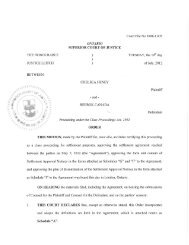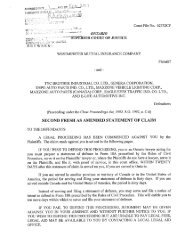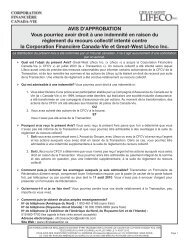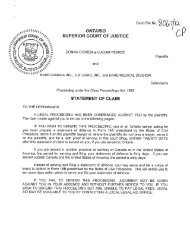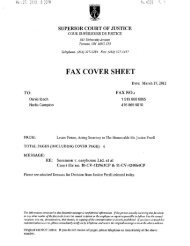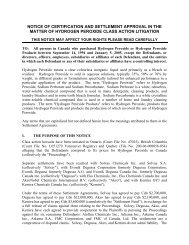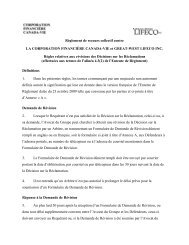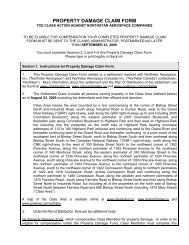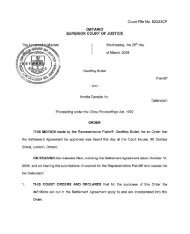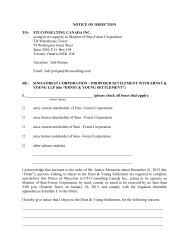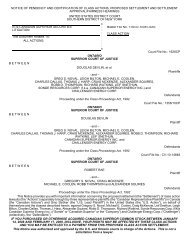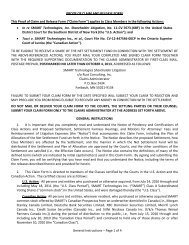Gariepy v. Shell Oil Co. - Classaction.ca
Gariepy v. Shell Oil Co. - Classaction.ca
Gariepy v. Shell Oil Co. - Classaction.ca
You also want an ePaper? Increase the reach of your titles
YUMPU automatically turns print PDFs into web optimized ePapers that Google loves.
say that the factual foundation for these claims is absent and that they ought not to be allowed toproceed. Indeed, in its factum, <strong>Shell</strong> states that it would be "an affront to justice to treat the Claimas true and provable" in light of these admissions. 35 The flaw in the defendants' argument on this point is that it attempts to introduce evidence intothe consideration of whether there is a <strong>ca</strong>use of action pleaded. It is well established, both by theRules of Civil Procedure, R.R.O. 1990, Reg. 194 and by the <strong>ca</strong>se law, that evidence is not admissibleon a motion to determine whether a statement of claim discloses a <strong>ca</strong>use of action. <strong>Co</strong>ntrary to thedefendants' position, I do not consider that the approach to that issue should be any different undersection 5(1)(a) just be<strong>ca</strong>use there happens to be evidence before the court on the certifi<strong>ca</strong>tion motion- a situation made necessary by the other requirements of section 5(1). I am fortified in myconclusion in this regard by the following quotation from Hollick v. Toronto (City) (2001), 205D.L.R. (4th) 19 (S.C.C.), where Chief Justice McLachlin said, at p. 33:"In my view, the class representative must show some basis in fact for each of thecertifi<strong>ca</strong>tion requirements set out in s. 5 of the Act, other than the requirement thatthe pleadings disclose a <strong>ca</strong>use of action." [emphasis added] 36 The above quotation, fairly read, holds that there is a requirement on the proposedrepresentative plaintiff to establish some basis in fact for the requirements set out in sections 5(1)(b)through 5(1)(e) of the Act but, conversely, there is no similar requirement that the representativeplaintiff establish some basis in fact for the requirements set out in section 5(1)(a). Therefore, it willbe sufficient for the purposes of section 5(1)(a) if the statement of claim alleges the necessary factsto found the <strong>ca</strong>use of action. I repeat that section 5(1)(a) refers to the "pleadings" disclosing a <strong>ca</strong>useof action. The appli<strong>ca</strong>ble test on that issue is well-established - see Hunt v. Carey Canada Inc.,[1990] 2 S.C.R. 959. Had the Legislature wished to change that approach, it could easily have doneso by stating, for example, that the claim had to disclose a "genuine issue for trial" or had "areasonable prospect of success" or any number of other well-known expressions that would suggestthat there was an obligation to provide an evidentiary foundation for the claim. The Legislature,however, chose not to do so when it passed the Act. 37 Absent a clear intention to alter this established practice, I conclude that it ought to continueto be applied. It also avoids turning the certifi<strong>ca</strong>tion motion into what otherwise would amount toa form of surrogate motion for summary judgment. It further avoids the court having to engage inany consideration of the degree to which the facts would need to be put forward by therepresentative plaintiff such as to satisfy any evidentiary requirement in support of the <strong>ca</strong>uses ofaction asserted. The approach <strong>ca</strong>nnot be altered by the defendants' assertion that the plaintiffs haveexpressly disavowed the facts underlying these claims in their cross-examinations. To follow thatroute would require the court to rely on what is, by definition, inadmissible evidence. 38 I now turn to the final issue that is raised by the defendants under this requirement. Thedefendants assert that there is no <strong>ca</strong>use of action at all for those members of the putative class whohave experienced no leaks in their pipes or fittings ("non-leakers") nor is there any <strong>ca</strong>use of actionfor those members of the putative class who have experienced leaks but have suffered damage onlyto the plumbing itself ("mere leakers") insofar as they claim the right to replace their entire plumbingsystem as a consequence. This assertion is based on the defendants' contention that the <strong>ca</strong>use ofaction in negligence only arises when damage occurs not merely when a negligent act is performed.



